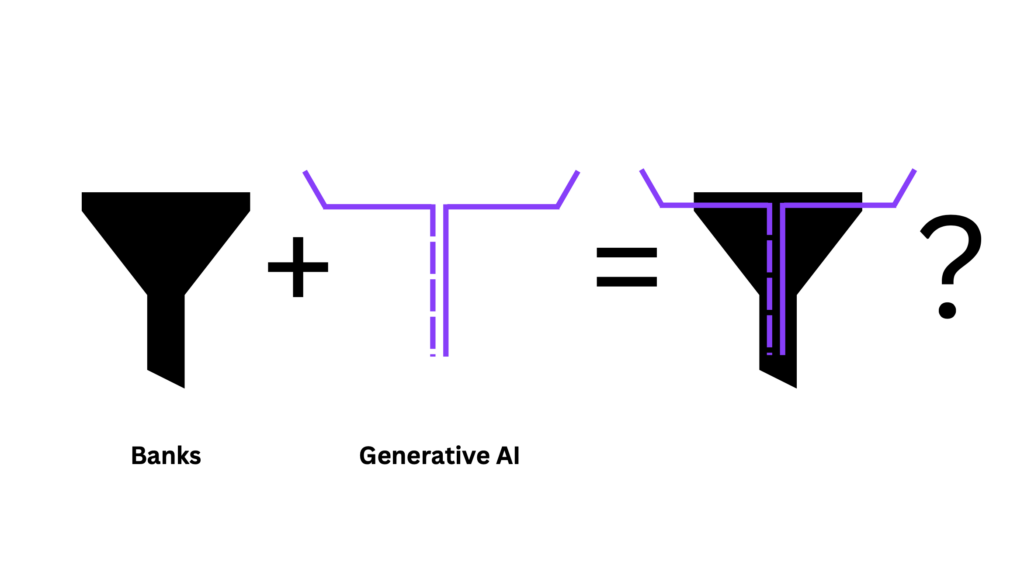Did a drafting exercise for a finance magazine and thought I would share it here as I think it definitely still applies and will for quite some time. I had to pick a 2024 trend within the financial services industry so what other than that overly hyped GenAI wagon. That wagon has to be a Cybertruck…
What is likely to follow when GenAI enters the Finance Industry?
Considering that Generative AI is the new eccentric kid strutting around town with his flashy digital backpack, it’s no shocking news that the vibrations from artificial intelligence will echo into the face of the finance industry. After all, those numbers in your modern bank run on a computer, and AI is essentially a set of formulas that runs on a computer.

BACK TO BANKING BASIC
If we were to strip the banking industry down to its core mechanism, we are talking about simple management of zeros and ones. Money at the end of the day is communicated in the form of numbers. The rule of math is that in order for it to work, it requires 100% accuracy. 1 plus 1 equals to 2. That rule needs to be rooted in its foundational understanding before any form of development on top of it can happen.
Let’s turn back time and strip down to the basics that anyone with a bag of coins would need from a bank. Trust. I trust that my coins will be safe in your box. And the value of my coins will not be affected by the complications and happenings in the real world. That my money (or the value of my money) will be protected in your keeping in the event of an apocalypse happening outside the bank.
On a second tier, you have the need for efficiency. The way the bank facilitates my access and the use of my money should make my life easier, so that I can focus on other more important things in my life that I truly value.
When those core foundations are reliably consistent, then growth comes into play in the form of interest rates, followed by other wants like interest and other financial services that allow the consumer of a bank to take calculated risk with their money. In a more modern approach in 1st world countries, banking services have been heavily focusing on refining that bridge between consumers and the goods and services that they intend on purchasing.
Bear in mind that trust is no longer a variable at the top of people’s heads in the realm of any banking service in 2024. That’s almost a given.
HOW WILL THE NEW KID BRING CHANGE?
So what exactly is going to happen as AI echoes into the suit-up and ever regulated finance industry? The supposedly new kid in town that has been marketed as a technological prowess that’s so advanced that might improve the lives of people to great new heights, and yet at the same time, casting looming clouds of fear hovering over bankers and financial institutions over that unfamiliarity. How exactly is he going to disrupt the known patterns in the realm of banking?
There’s one thing that we can be very certain of at this moment that the new kid will bring to your conference table.
His imposingly higher rate of analytical output.
Imagine pouring water into a traditional water funnel. Now the diameter of the top of the funnel has significantly narrowed, and the rate of the water streamlined out is faster than you can manage on the receiving end at present. How do financial institutions adapt to this new-age water funnel and the fast rate of water flow that’s coming out of it? How do you seamlessly reinvent your pail to receive that water, will you change the material of the funnel or reshape the thin ends of the funnel? How will you pour water in with more accuracy so that no drops are wasted? Or will you throw the funnel away completely?
That’s one of the most important variables we have to consider in all the complex equations that financial institutions have to reinvent, improve or adapt around.
What are they going to do with this higher rate of analytical output produced by GenAI?
Potentially, we can see 3 main branches of movements that’s going to happen.
NON-ADAPTIVE, ADAPTIVE and NEW SPROUTS.
1. Non-Adaptive
Non-adaptives are the most stubborn of them all. They choose to stand firm by all the patterns that they know and choose not to jump on the GenAI wagon. Maybe some will take a creative approach in totally betting on providing a noticeable edge in other non-efficiency related areas to keep the interest of their customers from other GenAI related distractions. For example, one simple way of doing that is to greatly increase the interest rate across all products and services. To push it radically, this group might also do a complete 180 to cater to a niche. There’s always something for everyone. What simpler way to remove the complexity of GenAI interfering with banking than to completely remove yourself from the sticky equation. Less is more after all.
2. Adaptive
At the center of the curve, you have the adaptive. These are all the energetic big boys in the rubber tiled playground. The mere size of their business leaves them no choice but to receive, learn, and incorporate GenAI into their systems, but they are happy to engage and get involved with the exotic new kid. They understand the importance of growth. However, the growth will inevitably be slow.
This process requires heavy reinventing and refinement of their existing business models and operating systems alongside GenAI. Meanwhile, to prevent the new kid from wrecking too much havoc in town, new regulations implemented by the finance authorities will be coming at them in the style of a deadpan double-edged sword. To further put pressure on their problem solving skills, this uncomfortable change in the grey area will create lots of people’s problems within their institutions. Their biggest strength can also be their biggest weakness. They have the numbers to back themselves as always. But the problem here is that people generally don’t respond well to change, let alone a change towards the unknown. Most people don’t want change on a conscious level. Life is perceived ‘easier’ and ‘safer’ that way.
Bankers love taking calculated risks. They need to be able to see a clear path towards quantifiable goals. The involvement of GenAI is almost threatening to this trait of every successful banker. At the core of every banker is an exceptional financial acumen with deep understanding of financial markets, investment strategies, and economic trends. They want to make informed decisions that steer towards their goals.
GenAI at this penetrating stage is rather chaotic and unrefined to be wholly received with open arms. But as the classic age-old saying, slow and steady wins the race?
3. New Sprouts
Lastly, we have the new sprouts. These are the brand new innovative approaches. Whenever a new technology is introduced to any industry, new blood with strong conviction of the new technological advancement will always challenge existing moulds by creating completely new ones. In this sphere, we’re talking about entrepreneurs and smaller tech-enthusiasts pumping completely new fintechs and banks into the industry to challenge the status quo. Taking into consideration that their ammunition is literally built on the foundation of those faster analytical outputs backed by GenAI, this means that the emergence of new guys will be fast. Those ruthless efficiencies backed by speed are exactly what they’re proud of and good at. The rapid bloom of fin-tech will create a highly competitive environment, which will purge the growth and optimization in the use of GenAI. They will inevitably be chaotic within themselves over here because they are literally selling and betting on the unknown here, you have to deal with the classical annoyance of anything new, which is to convince the minds of people to believe in the abstract. Eventually, gamification of money over here will evolve into a more intricate and highly saturated domain. We can already see that happening now.
Perhaps the purpose of some of this new blood isn’t to stand on their own, but to support large financial institutions going through the slow growth supported by their own subjective discovery. Collaborative efforts are important for the large institutions in order to speed the adaptation of GenAI up.
SOCIAL IMPLICATIONS
With all that’s predicative at the corporation level, how will the adaptability of GenAI into the finance industry affect our society on a more collective level? What are the social implications of something that’s so efficient’ in the context of finance?
The GenAI technology will heavily purge more options for consumers in ways that they can store their money. Gamification of money in the name of ‘growth’ or ‘investment’ will continue to rise. People will be introduced to more alternative ways to engage their money with financial corporations and fintechs, that will be marketed as means to improve their quality of lives.
Or does it? Does that complex relationship with money act as mere distraction from life? This newly reinvented relationship between consumers and financial institutions that has been penetrated by GenAI will most likely result in more numbers and fewer people in the equation.
Will this result in a way less intuitive relationship we have with money as a collective? Will we get so caught up in the game of zero and ones within the financial sphere that we drift so far away from the true meaning of money as a medium of exchange for the intangibles that are truly valuable in our lives.
Don’t forget the element of trust as our foundational need to engage a bank.
Will trust fade away in this changing landscape within the financial sector?…


No responses yet